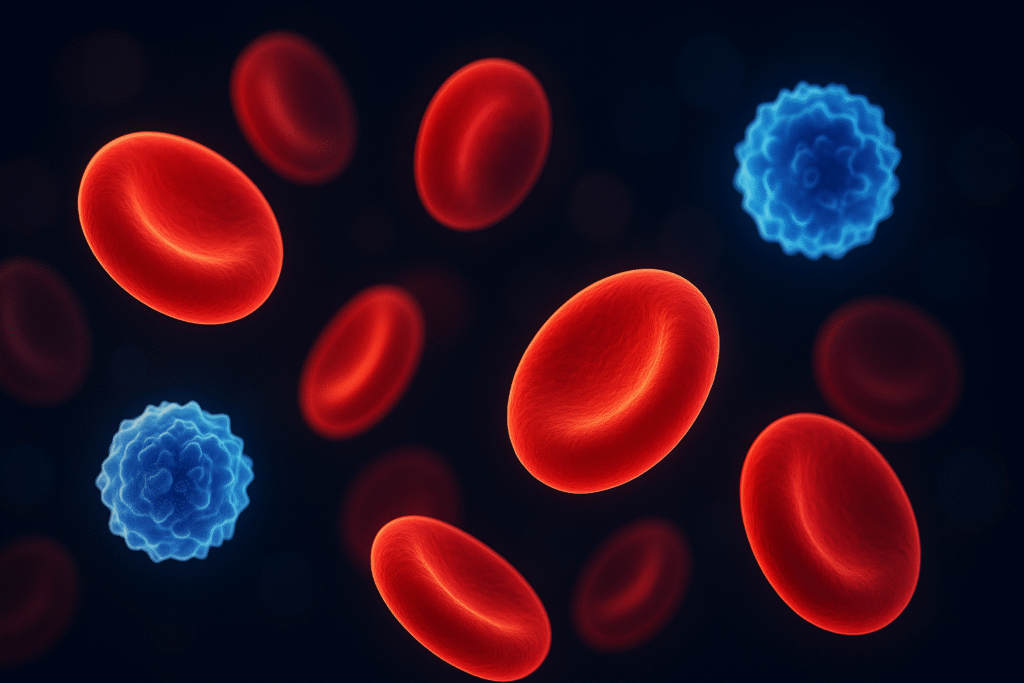What Is Darkfield Microscopy—and What Can It Tell Me?
Darkfield microscopy is a special way of looking at living blood under a microscope so that cells and tiny particles appear bright against a dark background. By changing how light enters the sample, a darkfield condenser blocks direct light and allows only scattered light to reach your eye or the camera. The result is a glowing, high-contrast image that can reveal details you won’t see with standard brightfield microscopes.
Plain-English idea: Imagine turning off the room lights and shining a flashlight past a dust mote—suddenly, that tiny speck sparkles. Darkfield works a bit like that, helping small, translucent structures stand out.
How Darkfield Microscopy Works (Without the Jargon)
-
Light comes in at an angle. A special ring-shaped “stop” in the condenser keeps straight-on light from hitting the sample.
-
Only scattered light is captured. Anything in the sample that bends or scatters the angled light becomes visible—bright on black.
-
Great for transparent stuff. Because many cells are clear, darkfield makes edges, movement, and outlines pop, which is perfect for real-time viewing of living samples.
What You’ll Typically See in a Live Blood Session
Note: Darkfield is observational. It shows shape, motion, and relative patterns. It does not diagnose disease. Interpretation should be done by trained professionals and—if needed—paired with standard medical testing.
1) Red Blood Cells (RBCs)
-
Shape: The classic round “coin-shaped” look.
-
Spacing: RBCs should float freely with a little space between them.
-
Clumping (Rouleaux): When many RBCs stack like coins, it may reflect sample handling, hydration status, or other influences—useful feedback for lifestyle discussion.
2) White Blood Cells (WBCs)
-
Movement & appearance: You may see larger, glowing cells with visible internal motion.
-
General interest: Viewers often find it meaningful to see immune cells in action; practitioners discuss what’s typical vs. atypical for education.
3) Platelets and Micro-Particles
-
Tiny sparkles: Small points of light can represent platelets or other particulates in the plasma.
-
Why it matters: Quantity, size, and distribution patterns can guide conversations about hydration, stress, recent meals, or other everyday factors.
4) Plasma Background
-
Clarity vs. debris: A relatively “clear” background is common in well-prepared samples.
-
Artifacts: Dust, air bubbles, and slide preparation issues can mimic structures—trained viewers learn to tell them apart.
What Darkfield Microscopy Cannot Do
It’s important to keep expectations grounded:
-
Not a diagnostic test. Darkfield is not used to diagnose medical conditions or replace lab panels.
-
Not a standalone measure of “toxins” or infection. Visual patterns should never be treated as proof without clinical correlation.
-
Not a treatment. It’s a visual tool for education, monitoring general patterns, and motivating healthy habits.
Why People Find It Helpful
-
Real-time feedback. Watching your cells move engages your curiosity and can motivate healthier habits (hydration, nutrient-dense meals, rest).
-
Lifestyle conversations. Practitioners can use observed patterns to explain concepts like circulation, oxidative stress, or the impact of ultra-processed foods in a way that’s easy to grasp.
-
Before/after comparisons. Some people like to view changes over time while they work on sleep, stress management, or nutrition—darkfield provides a visual logbook.
How a Session Usually Works
-
Finger stick: A small drop of blood goes on a clean slide under a coverslip.
-
Immediate viewing: Because the sample is fresh, you’ll often see lively motion.
-
Guided tour: A trained observer explains what you’re seeing—RBC shape, WBC movement, platelets, and background.
-
Education & next steps: You’ll discuss everyday habits that support healthy blood patterns: hydration, mineral-rich foods, gentle movement, and good sleep. If something looks unusual or you have symptoms, you’ll be encouraged to consult your healthcare provider for appropriate testing.
Healthy-Habit Tips That Support What You See Under the Scope
-
Hydrate consistently. Steady water intake helps circulation and saliva/urine pH management.
-
Eat a plant-forward plate. Colorful vegetables, greens, herbs, and quality proteins support mineral balance.
-
Move daily. Walking and light strength training promote oxygen delivery and blood flow.
-
Prioritize sleep & stress care. Your nervous system strongly influences circulation and recovery.
-
Work with a professional. If you have chronic conditions or take medications, tailor changes with a qualified provider.
Kind reminder: Educational microscopy is not a substitute for medical diagnosis or treatment. Partner with your clinician for labs and care decisions.
FAQs
Is darkfield microscopy safe?
Yes. It’s simply a way of viewing a tiny blood sample. There’s no radiation or invasive exposure—just light through a microscope.
Can darkfield find diseases early?
Darkfield offers visual patterns, not diagnoses. If something looks unusual or you feel unwell, follow up with standard medical testing.
How is darkfield different from brightfield?
Brightfield sends light straight through the sample (great for stained slides). Darkfield angles the light, making clear, living structures shine against black—great for contrast and movement.



Pingback: Fighting Cancer Without Chemo or Radiation - Pam Rumley's World | Coloring and Activity Books | Norah Press